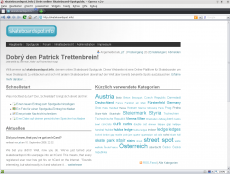Browser Configuration/Opera: Difference between revisions
No edit summary |
Re-branding edit |
||
| Line 1: | Line 1: | ||
{{Template:I18n/Language Navigation Bar|Tutorials/Opera}} | {{Template:I18n/Language Navigation Bar|Tutorials/Opera}} | ||
This tutorial explains how to configure Opera so that it will | This tutorial explains how to configure Opera so that it will blend with your Plasma applications. To do this, we'll need to install the Opera Oxygen Project skin, set Opera to use your chosen Plasma Desktop scheme, and change Opera's default fonts to the ones which KDE uses. | ||
'''Please note:''' This tutorial is written for Opera 10 or later. Make sure that you're using | '''Please note:''' This tutorial is written for Opera 10 or later. Make sure that you're using Plasma's default icon theme, Oxygen, since the Opera Oxygen Project skin uses icons from Oxygen. | ||
== Step 1: Installing the Skin == | == Step 1: Installing the Skin == | ||
| Line 26: | Line 26: | ||
Opera has two default fonts - the normal font and the monospace font. You can change these default fonts by clicking on them. Change the normal font to ''DejaVu Sans'' and change the monospace font to ''DejaVu Sans Mono''. | Opera has two default fonts - the normal font and the monospace font. You can change these default fonts by clicking on them. Change the normal font to ''DejaVu Sans'' and change the monospace font to ''DejaVu Sans Mono''. | ||
That's it! Now Opera will look and feel just like your | That's it! Now Opera will look and feel just like your Plasma applications. | ||
[[Image:Opera-kde4.png|center|230px]] | [[Image:Opera-kde4.png|center|230px]] | ||
Revision as of 16:52, 19 December 2009
Template:I18n/Language Navigation Bar This tutorial explains how to configure Opera so that it will blend with your Plasma applications. To do this, we'll need to install the Opera Oxygen Project skin, set Opera to use your chosen Plasma Desktop scheme, and change Opera's default fonts to the ones which KDE uses.
Please note: This tutorial is written for Opera 10 or later. Make sure that you're using Plasma's default icon theme, Oxygen, since the Opera Oxygen Project skin uses icons from Oxygen.
Step 1: Installing the Skin
Open Opera and navigate to the following link:
http://my.opera.com/community/customize/skins/info/?id=8141
Click "Download Skin" to install the Opera Oxygen Project skin.
Step 2: Applying the Skin & Changing the Color Scheme
Go to Tools -> Appearance.
In the "Skins" box, you will see a list of all the skins that are currently installed. Click on "opera_oxygen_project_[version]" to apply the Opera Oxygen Project skin to Opera.
Click on the menu box next to "Color Scheme" and select "System Color Scheme" to let Opera use KDE's color scheme.
Step 3: Changing the Font
Go to Tools -> Preferences. Click on the "Web Pages" tab.
Opera has two default fonts - the normal font and the monospace font. You can change these default fonts by clicking on them. Change the normal font to DejaVu Sans and change the monospace font to DejaVu Sans Mono.
That's it! Now Opera will look and feel just like your Plasma applications.

Source
This tutorial is based on Patrick Trettenbrein's blog entry entitled “How to make Opera 9.5 look native in KDE 4”. Additional updates have been made as Opera has been updated.
